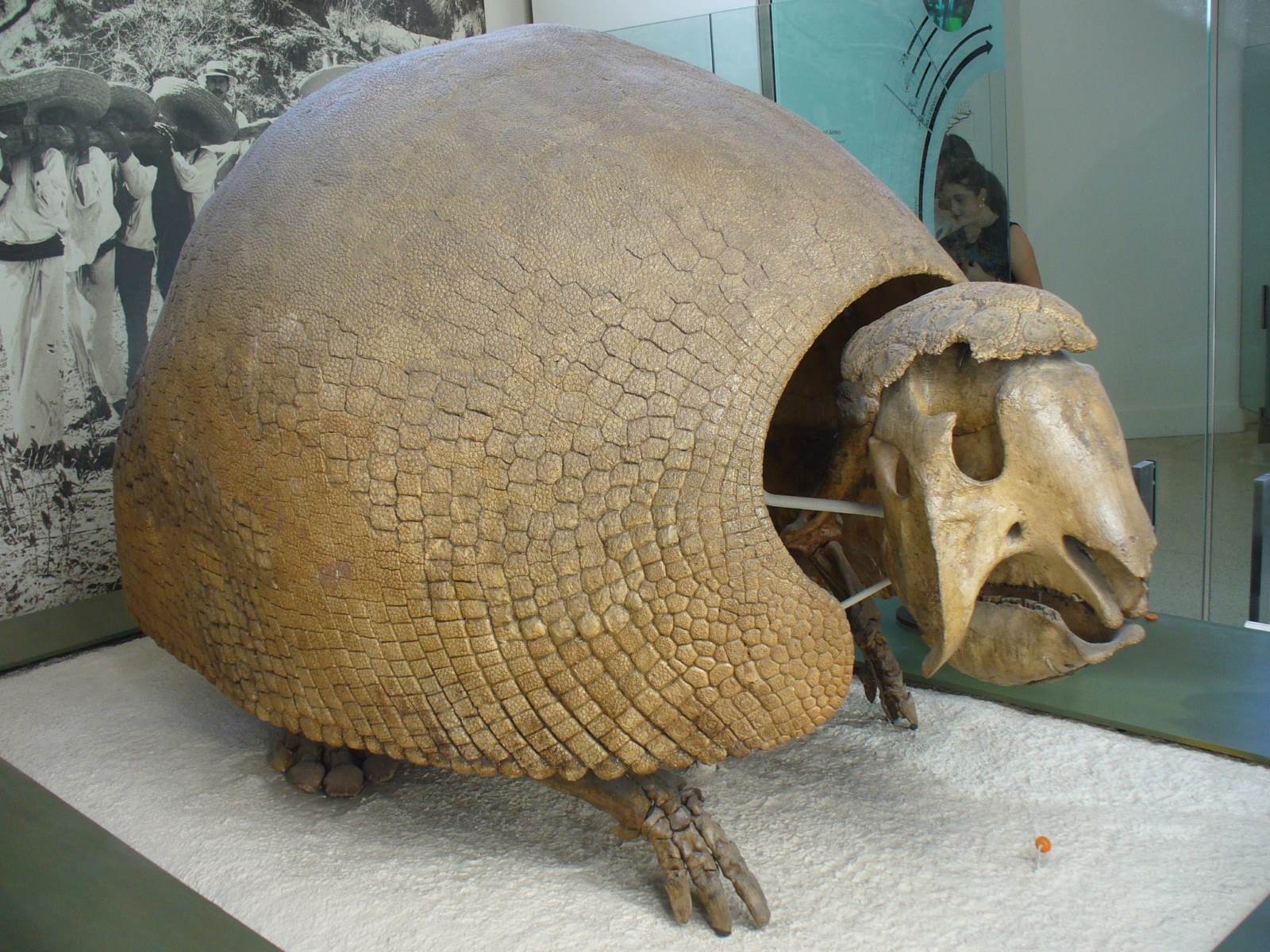
Glyptodon fossils offer a fascinating glimpse into the ancient world. These prehistoric creatures, resembling giant armadillos, roamed the Earth during the Pleistocene epoch. Glyptodons were armored giants, with bony plates covering their bodies, providing protection against predators. Their fossils have been found in various parts of South America, revealing much about their lifestyle and environment. Paleontologists study these remains to understand how Glyptodons lived, what they ate, and how they interacted with other species. From their unique shell structure to their massive size, Glyptodon fossils continue to intrigue scientists and enthusiasts alike. Dive into these 35 captivating facts about Glyptodon fossils and uncover the secrets of these ancient armored giants.
Key Takeaways:
- Glyptodons were massive, armored creatures that roamed South America during the Pleistocene epoch, and their fossils provide valuable insights into their habitat, lifestyle, and eventual extinction.
- The discovery of Glyptodon fossils has fascinated scientists and enthusiasts, shedding light on their physical characteristics, diet, and interactions with other prehistoric creatures.
What is a Glyptodon?
Glyptodon was a prehistoric mammal that roamed South America during the Pleistocene epoch. These creatures were part of the armadillo family but were much larger and more heavily armored. Let's dive into some fascinating facts about Glyptodon fossils.
-
Glyptodon means "grooved tooth" in Greek, named for the unique grooves on their teeth.
-
These creatures lived approximately 2.5 million to 10,000 years ago.
-
Glyptodon fossils have been found primarily in South America, especially in Argentina and Brazil.
-
They were herbivores, feeding mainly on grasses and other vegetation.
-
Their closest living relatives are modern armadillos.
Physical Characteristics of Glyptodon
Glyptodons were massive, armored creatures with some unique physical traits. Here are some interesting details about their appearance and structure.
-
They could grow up to 10 feet long and weigh as much as 2,000 pounds.
-
Their bodies were covered in a protective shell made of bony plates called osteoderms.
-
The shell was so strong it could withstand attacks from predators like saber-toothed cats.
-
Glyptodons had a long, armored tail that they could use as a weapon.
-
Their heads were also protected by a bony cap, making them look like walking tanks.
Discovering Glyptodon Fossils
The discovery of Glyptodon fossils has provided scientists with valuable insights into these ancient creatures. Here are some notable facts about these discoveries.
-
The first Glyptodon fossil was discovered in 1823 by Danish naturalist Peter Wilhelm Lund.
-
Charles Darwin also found Glyptodon fossils during his voyage on the HMS Beagle.
-
Many Glyptodon fossils are remarkably well-preserved, allowing scientists to study their anatomy in detail.
-
Fossilized Glyptodon shells are often found intact, showcasing their impressive size and structure.
-
Some fossils have been found with evidence of human interaction, suggesting early humans may have hunted them.
Glyptodon's Habitat and Lifestyle
Understanding the habitat and lifestyle of Glyptodons helps paint a picture of their daily lives. Here are some intriguing facts about where and how they lived.
-
Glyptodons preferred open grasslands and savannas, where they could graze on vegetation.
-
They were likely solitary animals, coming together only for mating.
-
Glyptodons had a slow, lumbering gait due to their massive size and heavy armor.
-
They had strong, clawed feet that helped them dig for food and create burrows.
-
Despite their size, Glyptodons were relatively slow-moving, making them vulnerable to predators.
Extinction of the Glyptodon
The extinction of Glyptodons marks the end of an era for these fascinating creatures. Here are some facts about their decline and eventual disappearance.
-
Glyptodons went extinct around 10,000 years ago, at the end of the last Ice Age.
-
Climate change likely played a significant role in their extinction, as their habitats changed drastically.
-
Human hunting may have also contributed to their decline, as early humans spread across the Americas.
-
The extinction of Glyptodons coincided with the disappearance of many other large mammals, known as the Pleistocene megafauna.
-
Despite their extinction, Glyptodons have left a lasting legacy through their well-preserved fossils.
Interesting Facts About Glyptodon Fossils
Glyptodon fossils continue to captivate scientists and enthusiasts alike. Here are some more intriguing facts about these ancient remains.
-
Some Glyptodon fossils have been found with bite marks, indicating they were preyed upon by large predators.
-
The structure of their teeth suggests they had a specialized diet, primarily consisting of tough, fibrous plants.
-
Fossilized Glyptodon dung, known as coprolites, has provided insights into their diet and digestive processes.
-
Glyptodon fossils have been found in a variety of environments, from riverbeds to caves.
-
Some fossils show evidence of disease and injury, offering clues about the challenges these creatures faced.
Glyptodon in Popular Culture
Glyptodons have made their mark not just in science but also in popular culture. Here are some fun facts about their appearances in media and entertainment.
-
Glyptodons have been featured in several documentaries about prehistoric life.
-
They appeared in the animated movie "Ice Age: Dawn of the Dinosaurs," where they were depicted as friendly, armored creatures.
-
Glyptodon models and replicas are popular exhibits in natural history museums around the world.
-
Artists and illustrators often depict Glyptodons in prehistoric landscapes, showcasing their impressive armor and size.
-
Glyptodons continue to inspire curiosity and wonder, reminding us of the incredible diversity of life that once roamed our planet.
The Fascinating World of Glyptodon Fossils
Glyptodon fossils reveal a lot about these ancient creatures. These armored giants roamed South America during the Pleistocene epoch. Their unique shell structure, similar to a turtle's, provided protection from predators. Fossils show they were herbivores, munching on plants and fruits. Their massive size, up to 2,000 pounds, made them formidable. Discoveries of Glyptodon fossils in various locations help scientists understand their habitat and behavior. These fossils also shed light on the climate and environment of their time. Studying them offers insights into the evolution of armadillos, their modern relatives. The more we learn about Glyptodon fossils, the clearer the picture of Earth's prehistoric past becomes. These ancient relics continue to captivate scientists and enthusiasts alike, reminding us of a world long gone.
Frequently Asked Questions
Was this page helpful?
Our commitment to delivering trustworthy and engaging content is at the heart of what we do. Each fact on our site is contributed by real users like you, bringing a wealth of diverse insights and information. To ensure the highest standards of accuracy and reliability, our dedicated editors meticulously review each submission. This process guarantees that the facts we share are not only fascinating but also credible. Trust in our commitment to quality and authenticity as you explore and learn with us.


